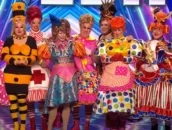
 Many quintessential English traditions are hard to describe to non-Brits ….. one of them being pantomime dames whose origins go way back beyond Ru Paul being a twinkle in his parent’s eyes. Panto(mime) comes from Music Halls and variety, commedia dell’arte, and the Regency era of clowning, led by the great Joseph Grimaldi. In the late 19th century, music hall stars were cast in pantos to draw in wider audiences. Slowly pantomimes became a more inclusive, family affair, with a man in drag center stage to welcome everyone in from the cold.
Many quintessential English traditions are hard to describe to non-Brits ….. one of them being pantomime dames whose origins go way back beyond Ru Paul being a twinkle in his parent’s eyes. Panto(mime) comes from Music Halls and variety, commedia dell’arte, and the Regency era of clowning, led by the great Joseph Grimaldi. In the late 19th century, music hall stars were cast in pantos to draw in wider audiences. Slowly pantomimes became a more inclusive, family affair, with a man in drag center stage to welcome everyone in from the cold.
The theatre has always embraced cross-dressing and in the early days of modern panto, women took on the principal male roles, allowing them to show the audience a little leg and look and be elegant So as a counter-balance the older male comedians were put into female roles where they could be caricatured and funny.
Panto dames are not trying to make any social comment on femininity or masculinity they are just trying to be funny. There is no attempt to be glamorous and in panto it should be obvious that the dame is really a man in a woman’s clothes. The public conception of panto vs drag is very clear as they are usually perceived so differently. Panto dames have always been widely accepted as family-friendly entertainment, whereas drag has historically been, and continues to be, subject to significant discrimination in certain quarters.
Last year a group of some of the UK’s best Pantomime Dames brought the house down when they performed on Britain’s Got Talent. They even put a big smile on Simon Cowell’s face : no mean feat

